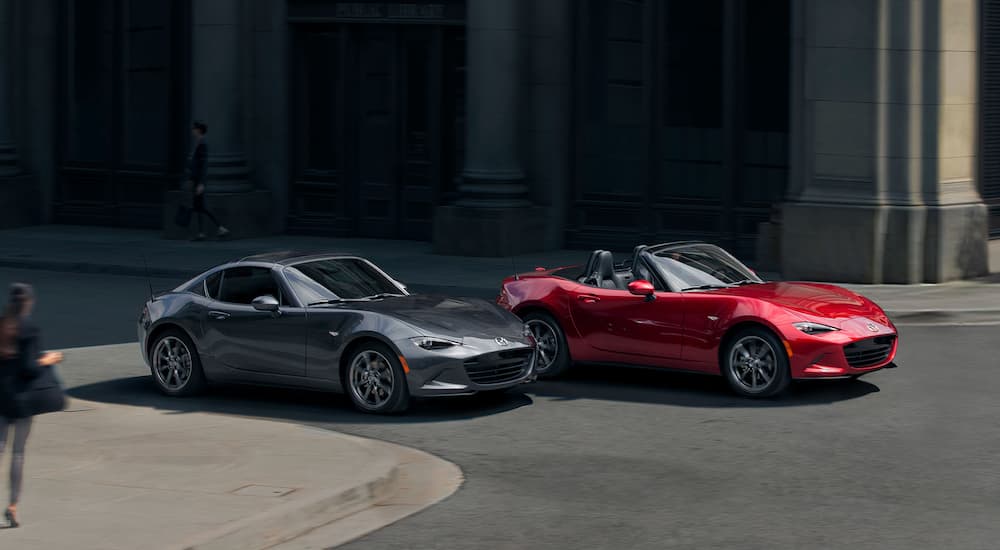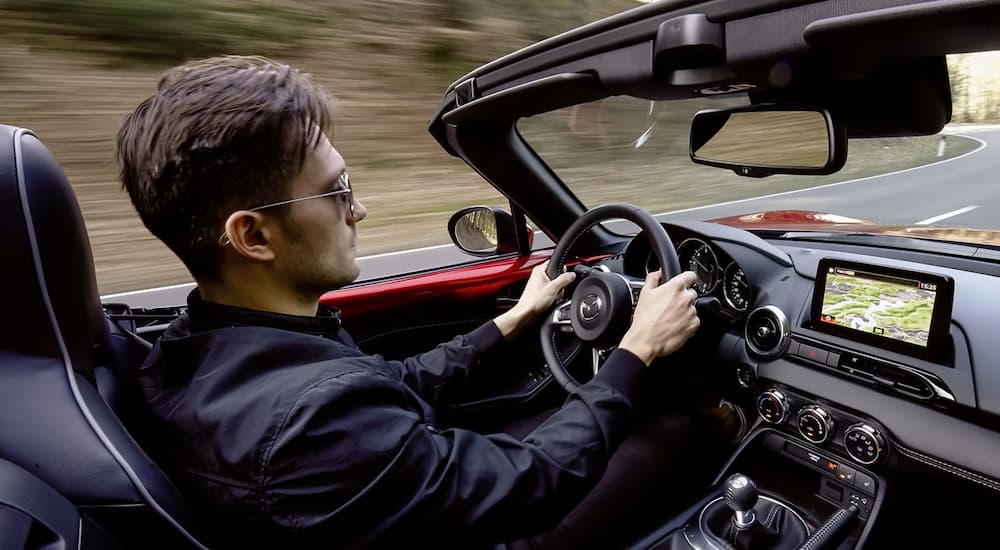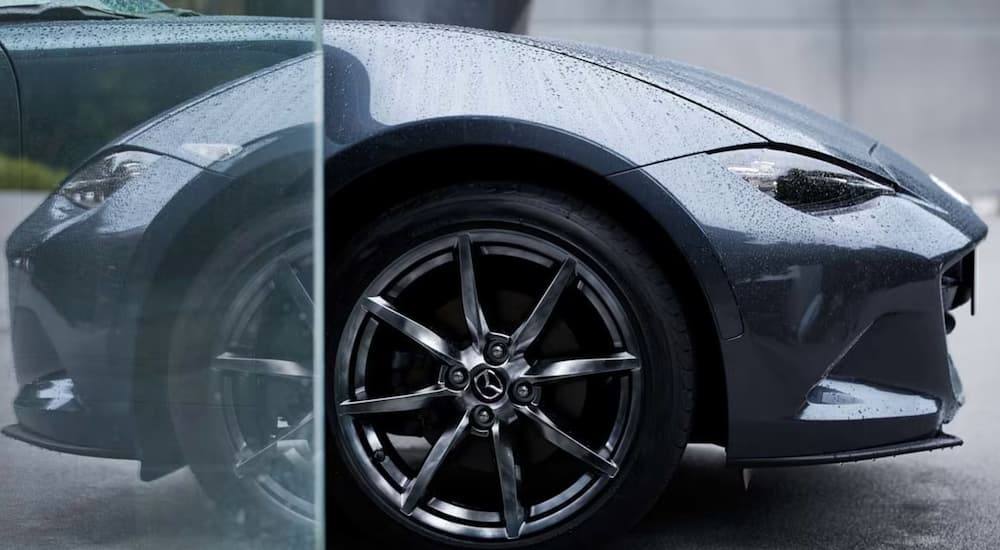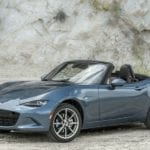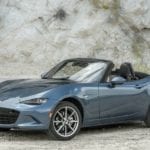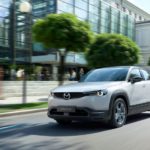With the SUV continuing its meteoric rise in popularity and the pickup truck becoming more refined and luxurious with each passing model year, the sports car almost seems like a relic of a bygone era. While there are still those that favor them for their style and performance, they’re not as popular as they once were. Then, there’s the Mazda Miata. Affectionately known as the Roadster in its native Japan, the Miata seems to be the lone exception, always in vogue and maintaining its popularity since its debut in 1989. Today, we examine the history of this shooting star that remains as bright as ever. The ideal combination of cost-effectiveness and high performance has set it apart from its competitors for years. After reading this, you might gain a new appreciation for the vehicle the next time you see one at your local Mazda dealer.
A Bold Beginning at the End of an Era: 1989-1997
As one can deduce from popular culture, the 1980s were a decade of flashy designs and bold colors. The Camaro and Mustang still carried on in new incarnations, Toyota elevated performance courtesy of the Supra, and even Mazda revved up the action with its RX-7 model. For all the decadence and excess that continues to be associated with the decade, the Miata arrived at the tail end. A throwback to the British sports cars of the ‘50s and ‘60s, it was adequately priced and had much to offer in terms of performance.
In an age where high performance was commonly associated with V8 powertrains utilized by American Muscle cars of old, the Miata was somewhat ahead of its time in offering a slimmed-down offering in the form of a 1.6L four-cylinder engine. This still produced an adequate amount of horsepower with a rating of 114 hp. While the powertrain was slightly smaller than its contemporaries, the Miata still benefited from a RWD drivetrain and a sophisticated five-speed manual transmission. This was upgraded in 1994 to a 1.8L engine, whose horsepower rating was slightly higher at 129 hp.
With its lower center of gravity and ultra-comfortable interior, the Miata offered the sophistication of a European sports car but with the accessibility that made it easily attainable for the average income. For those who always wanted a convertible with style and presence, the Miata delivered on this front. One aesthetic choice that would be dropped by 1997 was the retractable headlamps of the vehicle’s front end. While these had been widely popular during the 1980s and had been a trademark of several vehicles, they had eventually proven to be a hindrance to pedestrian safety.
Another Era Ends and a New Millennium Begins: 1998-2005
It was the 1998 model year that introduced the world to the second generation of the Mazda Miata. Knowing what we know with the ability of hindsight, it’s quite amazing that the Miata continued to have a presence on the market despite the massive shift in trends that had occurred by the late 1990s. After all, this was the era when large SUVs were gaining notoriety, and offerings from Kia and Hyundai were changing the way many consumers thought of practicality. Even the Ford Mustang by this point had been relegated to the status of a coupe. The Miata stayed true to form and, as we’ve seen with Mazda several times before, perfection was improved upon.
While the new Miata had very little that changed about it in regards to style and design—except for the retractable headlights that were now gone and a new front end to accommodate the new headlamps—its powertrain once again received a significant upgrade. The 1.8L engine remained in place, but improvements made to the engine’s compression ratio and intake system allowed for better performance. A horsepower rating of 140 hp was the end result and one that was rather impressive.
While the changes to the Miata have been relatively minimal since its inception, the 2001 model year would see a facelift that heightened the aesthetic that made the vehicle even more popular. The Miata was given a suave new interior that greatly improved its luxurious appearance, and while the redesigns to the exterior vehicle were slight, they did help the Miata benefit from a new sportier look that was more in tune with its roadster persona.
With the new millennium now in full swing, the Miata would graduate to an available six-speed manual transmission by 2005. This was also the era of the Mazdaspeed variation of the Miata, which saw the vehicle receive a turbocharged 1.8L engine. With 178 hp and the ability to go from 0-60 mph in a mere 6.7 seconds, Mazda proved they were still ahead of the curve and competition.
Life in the Fast Lane and Immortality in the Winner’s Circle: 2006-2015
A phrase that gets used quite a lot in describing innovation in the automotive industry is “you can’t reinvent the wheel.” Perhaps this is true, but you can break the mold and defy all expectations. The 2006 model year marked only the third generation of the Miata since its original debut. This speaks to its ability to remain popular and relevant amid a continuous change in trends.
There were a few notable changes, the two most significant being a bold new powertrain and retractable hardtop. Easily one of the most innovative features in recent years, the hardtop could be retracted without hindering the vehicle’s trunk space. The Miata now had a new 2.0L engine, which produced 170 horsepower. Five-speed and six-speed manual transmissions made the ride more sophisticated and allowed drivers to exert maximum control over the vehicle. Of all the achievements made at this time, one of the most notable was the positive reception the vehicle received from Car and Driver Magazine, which listed it as one of its top ten vehicles from 2006 to 2013. Now that’s some consistency we can get behind.
The Present and the Future
The biggest update to the Miata in recent years was in 2018 when its 2.0L engine was advanced once again to a horsepower rating of 181 hp. The Miata that exists today is 220 lbs lighter than its predecessor and four inches shorter. By scaling back on the size and upgrading its performance, it’s quite possible that the Miata is one step closer to achieving total and complete perfection. Over two decades into the new millennium, the Mazda Miata is still with us, breaking the rules, defying the odds, and ensuring a legacy that many future generations will get to enjoy.
So now, we ask ourselves, what will happen with the Mazda Miata next? If the past has taught us one important lesson, it’s that the Miata is one vehicle that continues to defy the odds and discover bold and impressive new ways to reinvent itself. With the wide leaps and bounds at which the automotive industry evolves and changes, it’s virtually impossible to determine where the road ahead will see the Miata traveling. Perhaps it will remain the same for years to come, a symbol of undying perfection that still manages to astonish critics and consumers alike. After all, it’s lasted this long, and its longevity over the past several years has certainly spoken for itself.
